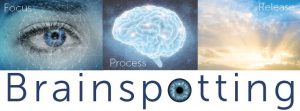
A revolutionary mind-body approach to quickly
release and heal trauma
Brainspotting is a gentle, mindfulness-based approach in which the client-practitioner relationship offers a safe alliance as the mind and body work together to dismantle the trauma. Physical and emotional symptoms, faulty self-perceptions and relationship stresses accompanied by outdated beliefs can shift so that new, more adaptive perspectives can develop and thrive.
POWERFULLY TRANSFORM ISSUES SUCH AS:
Stress / Anxiety
Trauma
Divorce
Depression
Self-limiting beliefs
Unexpected life change
Shame and victim consciousness
Loss of a loved one
Lack of self-worth
Sexual or physical abuse
Early attachment difficulties
Peak performance issues
Emotional blocks
Lack of passion
Money issues
PTSD
How Does Brainspotting Work?
Brainspotting is based on the neurobiological findings that the brain can heal itself. Research indicates that a brainspot connects your eye gaze position to neurological locations or networks in your brain.
Trauma overwhelms the brain’s processing leaving pieces of the unprocessed experiences frozen in time and space. Brainspotting provides safe access to the deeper places where this trauma is stored bypassing the neocortex (rational or thinking brain) to get to the subcortex (emotional, feeling, instinctual brain).
Along with certain somatic (body) cues, the practitioner and client are able to access those emotional places and allow the frozen fragments of information to begin to be dissolved. Together the practitioner and client are present to safely witness the brain processing in its own unique way, whatever is being released.
The client is assisted in observing what happens without becoming overwhelmed by the experience, or having to revert to disconnecting as a way to manage the experience. The practitioner literally and emotionally holds the “spot” and a safe space for the client as the processing continues until, over the course of sessions, all activation has been drained from the system.
How Brainspotting Can Help
Emotion and pain, when untreated, can interfere with daily functioning, goal achievement, relationship satisfaction, and peace of mind. The goal of Brainspotting is accessing and focusing the client’s self-healing capacities to release the stuck trauma and its hold on our lives.
The mindful attention between the therapist and client allows for a safe space as Brainspotting helps the brain/mind/body to work in harmony to dismantle the trauma, symptoms, somatic/body distress, and outdated beliefs for new awareness, connections, and inner resources to develop.
What to expect in a session:
Brainspotting utilizes a technique called Bilateral Stimulation. While wearing headphones, specifically designed music is used to activate both the left and right hemispheres of the brain which facilitates making new and better connections for emotional balance and optimal processing.
A client presents an issue they want to work on that they have activation (level of disturbance) around. Sensations are located in the body. On a scale of 0-10 (0 being none) the client rates the activation.
Moving a pointer across the visual eye field the brainspot is located by the intensity of the mind-body response.
Focusing on the spot allows access to deep parts of the brain where difficult feelings and sensations are held. This part of the brain is non-verbal, non-cognitive with the ability to re-calibrate itself.
The client is then invited to observe their internal process without judgment; this process may include body sensations, memories, emotional feelings, and thoughts that arise naturally.
At times, the client may feel nothing is going on or have no words to describe it—which indicates the deep subcortical brain (unconscious and non-verbal) is at work. The process continues, with the client usually having a reduction in activation number.
Brainspotting doesn’t necessarily end when the session ends. Like a computer program, the processing can run in the background for hours, days or, sometimes, weeks. The client may feel open, raw and tired after a session. It is best to have some space afterwards for self-care.
Feedback from sessions include many ways clients lives have changed. Release of grief, heart openings, greater self-acceptance, shifts in relationships, reduced pain and freedom from lifelong effects from trauma.
Brainspotting is unique from other therapeutic techniques in that it is being used not only in trauma and healing work, but also in the areas of peak performance and spiritual consciousness.
“Where you look effects how you feel”
David Grand Ph.D. developer of Brainspotting
